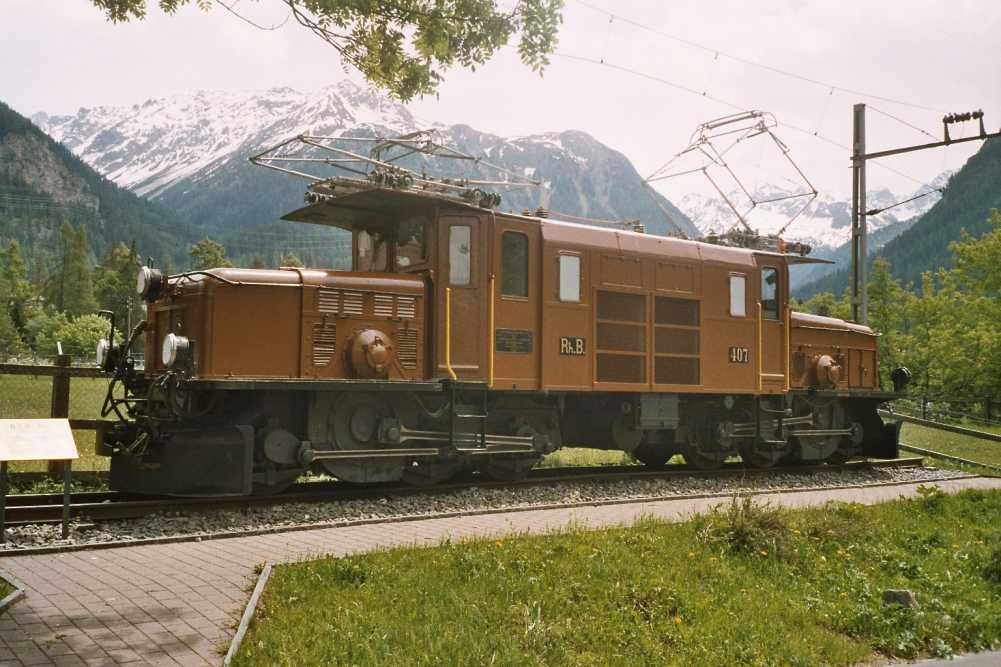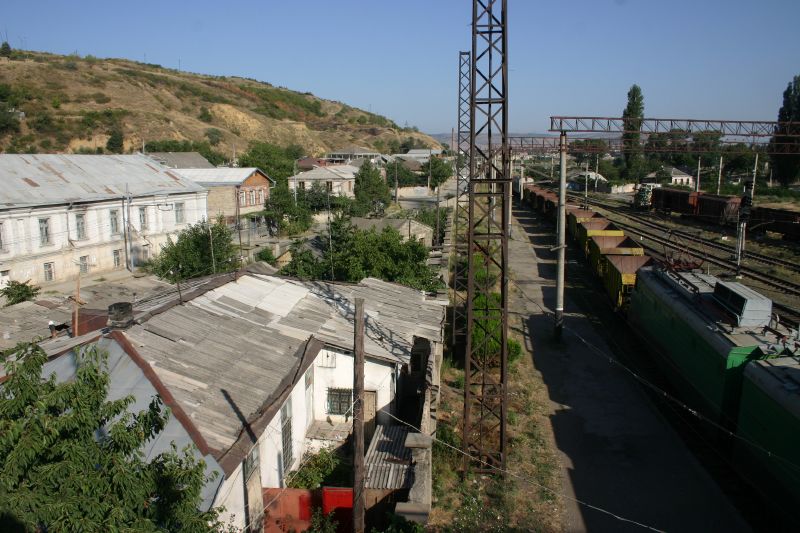|
Borjomi–Bakuriani Railway
The Kukushka (Russian for "little cuckoo") is a long Narrow gauge railway, narrow-gauge railway line linking the town of Borjomi (820 m asl) to the Daba (settlement), daba and ski resort of Bakuriani (1,700 m asl) in Georgia (country), Georgia. The construction of this line began in 1897, when Georgia was still part of the Russian Empire. The difficult terrain caused construction to take four years, and the first train ran in January 1902. Gustave Eiffel was commissioned by the Romanovs to design the Eiffel Bridge, Tsagveri over the Tsemistskhali River between the stations of Tsaghveri and Tsemi. Originally, trains were pulled by a steam engine built by H.K. Porter, Inc., H.K. Porter, imported from America, and passengers travelled in open carriages protected by handrails. The line was electrified in 1966, when the small steam engine was replaced by an electric "Crocodile (locomotive), crocodile" locomotive made by the Škoda Works, Škoda works in Czechoslovakia. The line is ... [...More Info...] [...Related Items...] OR: [Wikipedia] [Google] [Baidu] |
Borjomi
Borjomi ( ka, ბორჯომი) is a resort town in south-central Georgia, 160 km from Tbilisi, with a population of 11,122 (2021). It is one of the municipalities of the Samtskhe–Javakheti region and is situated in the northwestern part of the region in the picturesque Borjomi Gorge on the eastern edge of the Borjomi-Kharagauli National Park. The town is noted for its mineral water industry (which is the number one export of Georgia), the Romanov summer palace in Likani, and the World Wide Fund for Nature-site Borjomi-Kharagauli National Park. Borjomi mineral water is particularly well known in those countries which were part of the former Soviet Union; the bottling of mineral water is a major source of income for the area. Because of the supposed curative powers of the area's mineral springs, it is a frequent destination for people with health problems. Borjomi is also home to the most extensive ecologically-themed amusement park in the Caucasus. History In the ... [...More Info...] [...Related Items...] OR: [Wikipedia] [Google] [Baidu] |
Crocodile (locomotive)
Crocodile (German ''Krokodil'') electric locomotives are so called because they have long "noses" at each end, reminiscent of the snout of a crocodile (see also Steeplecab). These contain the motors and drive axles, and are connected by an articulated center section. The center section usually contains the crew compartments, pantographs and transformer. The name was first applied to Swiss locomotives. Sometimes the term is applied to locomotives in other countries of a similar design. History Switzerland Class Ce 6/8 A prototype locomotive, SBB-CFF-FFS Ce 6/8 I number 14201, was ordered in June 1917. The production "Crocodiles" were the series ''SBB Ce 6/8 II'' and ''SBB Ce 6/8 III'' locomotives of the SBB, Swiss Federal Railways, built between 1919 and 1927. There were 33 class Ce 6/8 II and 18 class Ce 6/8 III, making a total (excluding the prototype) of 51 locomotives. These locomotives were developed for pulling heavy goods trains on the steep tracks of the Gotthar ... [...More Info...] [...Related Items...] OR: [Wikipedia] [Google] [Baidu] |
Railway Lines In Georgia (country)
Rail transport (also known as train transport) is a means of transport that transfers passengers and goods on wheeled vehicles running on rails, which are incorporated in tracks. In contrast to road transport, where the vehicles run on a prepared flat surface, rail vehicles ( rolling stock) are directionally guided by the tracks on which they run. Tracks usually consist of steel rails, installed on sleepers (ties) set in ballast, on which the rolling stock, usually fitted with metal wheels, moves. Other variations are also possible, such as "slab track", in which the rails are fastened to a concrete foundation resting on a prepared subsurface. Rolling stock in a rail transport system generally encounters lower frictional resistance than rubber-tyred road vehicles, so passenger and freight cars (carriages and wagons) can be coupled into longer trains. The operation is carried out by a railway company, providing transport between train stations or freight customer ... [...More Info...] [...Related Items...] OR: [Wikipedia] [Google] [Baidu] |
Time Table Of Borjomi%E2%80%93Bakuriani Train
Time is the continued sequence of existence and events that occurs in an apparently irreversible succession from the past, through the present, into the future. It is a component quantity of various measurements used to sequence events, to compare the duration of events or the intervals between them, and to quantify rates of change of quantities in material reality or in the conscious experience. Time is often referred to as a fourth dimension, along with three spatial dimensions. Time has long been an important subject of study in religion, philosophy, and science, but defining it in a manner applicable to all fields without circularity has consistently eluded scholars. Nevertheless, diverse fields such as business, industry, sports, the sciences, and the performing arts all incorporate some notion of time into their respective measuring systems. 108 pages. Time in physics is operationally defined as "what a clock reads". The physical nature of time is ... [...More Info...] [...Related Items...] OR: [Wikipedia] [Google] [Baidu] |
Andesite
Andesite () is a volcanic rock of intermediate composition. In a general sense, it is the intermediate type between silica-poor basalt and silica-rich rhyolite. It is fine-grained (aphanitic) to porphyritic in texture, and is composed predominantly of sodium-rich plagioclase plus pyroxene or hornblende. Andesite is the extrusive equivalent of plutonic diorite. Characteristic of subduction zones, andesite represents the dominant rock type in island arcs. The average composition of the continental crust is andesitic. Along with basalts, andesites are a component of the Martian crust. The name ''andesite'' is derived from the Andes mountain range, where this rock type is found in abundance. It was first applied by Christian Leopold von Buch in 1826. Description Andesite is an aphanitic (fine-grained) igneous rock that is intermediate in its content of silica and low in alkali metals. It has less than 20% quartz and 10% feldspathoid by volume, with at least 65% of the fe ... [...More Info...] [...Related Items...] OR: [Wikipedia] [Google] [Baidu] |
Georgian Railways
Georgian Railway LLC ( ka, საქართველოს რკინიგზა, tr) is the national railway company of Georgia. A vital artery linking the Black Sea and the Caspian Sea, it sits on the shortest route between Europe and Central Asia. Built to standard Russian gauge, at present the fully electrified mainline of the Georgian Railway is 1,323.9 km (total: 1,576 km) in length, consisting of 1,422 bridges, 32 tunnels, 22 passenger and 114 goods stations. In 2017, Georgian Railways passenger ridership was 2,684,000, of which 100,000 were international passengers, the rest domestic. History Founded in 1865, operations started in 1871 between Poti and Kvirila (present day Zestaponi). The first passenger train ran on October 10, 1872, from Poti to Tbilisi central station. From this central spine, the railway network expanded with links to: Rioni to Kutaisi (1877), Rioni-Tkibuli (1887), Zestafoni to Chiatura (1895). The Tbilisi to Baku line became op ... [...More Info...] [...Related Items...] OR: [Wikipedia] [Google] [Baidu] |
Czechoslovakia
, rue, Чеськословеньско, , yi, טשעכאסלאוואקיי, , common_name = Czechoslovakia , life_span = 1918–19391945–1992 , p1 = Austria-Hungary , image_p1 = , s1 = Czech Republic , flag_s1 = Flag of the Czech Republic.svg , s2 = Slovakia , flag_s2 = Flag of Slovakia.svg , image_flag = Flag of Czechoslovakia.svg , flag = Flag of Czechoslovakia , flag_type = Flag(1920–1992) , flag_border = Flag of Czechoslovakia , image_coat = Middle coat of arms of Czechoslovakia.svg , symbol_type = Middle coat of arms(1918–1938 and 1945–1961) , image_map = Czechoslovakia location map.svg , image_map_caption = Czechoslovakia during the interwar period and the Cold War , national_motto = , anthems = ... [...More Info...] [...Related Items...] OR: [Wikipedia] [Google] [Baidu] |
Škoda Works
The Škoda Works ( cs, Škodovy závody, ) was one of the largest European industrial conglomerates of the 20th century, founded by Czech engineer Emil Škoda in 1859 in Plzeň, then in the Kingdom of Bohemia, Austrian Empire. It is the predecessor of today's Škoda Auto, Doosan Škoda Power and Škoda Transportation companies. History 1859–1899: establishment of Škoda The noble Waldstein family founded the company in 1859 in Plzeň, and Emil Škoda bought it in 1869. It soon established itself as Austria-Hungary's leading arms manufacturer producing heavy guns for the navy, mountain guns or mortars along with the Škoda M1909 machine gun as one of its noted products. Besides producing arms for the Austro-Hungarian Army, Škoda has ever since also manufactured locomotives, aircraft, ships, machine tools, steam turbines and equipment for power utilities. In 1859, Count Wallenstein-Vartenberk set up a branch of his foundry and engineering works in Plzeň. The output of ... [...More Info...] [...Related Items...] OR: [Wikipedia] [Google] [Baidu] |
Eiffel Bridge, Tsagveri
The Eiffel Bridge is a bridge over the Tsemistskal river, on the Borjomi–Bakuriani railway near the town of Tsagveri. History Grand Duke Michael Nikolaevich of Russia ordered the bridge from the French engineer-constructor and bridge builder Gustave Eiffel Alexandre Gustave Eiffel (born Bonickhausen dit Eiffel; ; ; 15 December 1832 – 27 December 1923) was a French civil engineer. A graduate of École Centrale des Arts et Manufactures, he made his name with various bridges for the French railway .... The construction of the bridge started in 1897 over the Tsemistskal River. The construction of the bridge was carried out by the constructor Besarion Keburia . From January 1902, the first "Kukushka" train passed through the Borjomi-Bakuriani narrow-gauge railway line and over the bridge. References External linkstravelinborjomi.geambebi.ge Bridges in Georgia (country) {{Georgia-struct-stub ... [...More Info...] [...Related Items...] OR: [Wikipedia] [Google] [Baidu] |
Bakuriani
Bakuriani ( ka, ბაკურიანი) is a daba and a ski resort in the Borjomi district of Georgia. It is located on the northern slope of the Trialeti Range, at an elevation of 1,700 meters (5,576 feet) above sea level. Geography The region around Bakuriani is covered by coniferous forests (mainly made up of spruce). The resort lies from Borjomi and is located within the so-called Bakuriani Depression/caldera. The resort is connected with Borjomi by an electrified narrow-gauge railway. The present-day area of the town was built up by lava flows from the nearby Mukhera volcano. Winter sports Ski resort The ski area of the resort is split into two separate parts: Didveli and Kokhta/Kokhta-Mitarbi. Mount Kokhta provides a maximum skiable altitude of , whereas the highest lift in Didveli reaches . The first ski base was opened in 1932. From Bakuriani to Kokhtagori Mountain () and Tskhratskaro Pass () there are ski lifts, ski tramps. There is artificial snowfall on ... [...More Info...] [...Related Items...] OR: [Wikipedia] [Google] [Baidu] |
Romanovs
The House of Romanov (also transcribed Romanoff; rus, Романовы, Románovy, rɐˈmanəvɨ) was the reigning imperial house of Russia from 1613 to 1917. They achieved prominence after the Tsarina, Anastasia Romanova, was married to the First Tsar of Russia, Ivan the Terrible. The house became ''boyars'' (the highest rank in Russian nobility'')'' of the Grand Duchy of Moscow and later of the Tsardom of Russia under the reigning Rurik dynasty, which became extinct upon the death of Tsar Feodor I in 1598. The Time of Troubles, caused by the resulting succession crisis, saw several pretenders and imposters ( False Dmitris) fight for the crown during the Polish–Muscovite War of 1605–1618. On 21 February 1613, a ''Zemsky Sobor'' elected Michael Romanov as Tsar of Russia, establishing the Romanovs as Russia's second reigning dynasty. Michael's grandson Peter I, who established the Russian Empire in 1721, transformed the country into a great power through a series of war ... [...More Info...] [...Related Items...] OR: [Wikipedia] [Google] [Baidu] |

.jpg)






